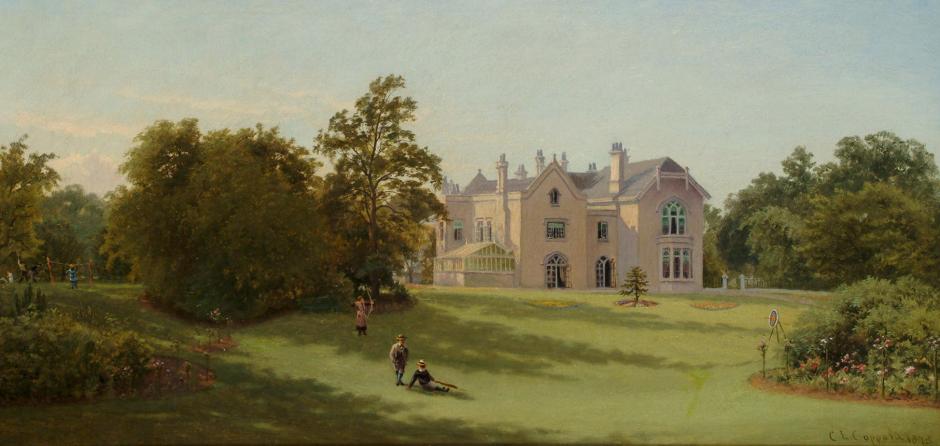Some modern sports owe their origins to the games of childhood catalogued by Pieter Brueghel the Elder in his painting shown in the previous article. Among those were games played using racquets such as badminton.

The painting that marks the coming of age of badminton is Charles Law Coppard’s Summer Sports in the Garden of a Country House from 1878. In its foreground are two men wearing hats, one of them holding a cricket bat. Behind them a woman is engaged in archery, and at the left side are two badminton players with a net strung high between them, much as in the modern sport.

While working in Glasgow, John Lavery painted a series of views of tennis games and players, including The Tennis Party, from 1885. This follows the approach adopted by Naturalists such as Bastien-Lepage in being quite loose in the surrounds, but delivering fine detail in the figures and nearby. That includes the tennis players themselves, and the wire netting surrounding the court.

Unfortunately, Laura Theresa Alma-Tadema’s Battledore and Shuttlecock is undated and I don’t know how much reliance can be placed on its title. Its players aren’t young children, suggesting that they may have played badminton when outdoors.

Lawn Tennis, or Memories (1889) is almost a pastel collage of paintings of Fernand Khnopff’s sister, that on the left dressing her in the same high-necked white dress as in her portrait of 1887. He shows here how skilled he has become at constructing the feeling of otherworldliness so characteristic of his paintings.

Tennis at Newport (1920) is one a series of paintings made by George Bellows in 1919-20 from sketches and studies made during summer tennis tournaments at the Newport Casino in Rhode Island. His interest is less in the sport taking place, and much more in the social event going on around it. This painting is set in the late afternoon, as the shadows grew long.
Watersports also flourished during the nineteenth century.

The most famous of Alfred Sisley’s paintings from his first trip to England is Regatta at Molesey (1874), one of the gems of the Musée d’Orsay in Paris. This small competitive event had only been established in 1867, and still takes place on the same stretch of the River Thames not far from Hampton Court. This painting was bought by Gustave Caillebotte, another enthusiast of watersports, for his collection of Impressionist works.
When Thomas Eakins returned to Philadelphia in 1870, he embarked on a group of rowing scenes, in a total of eleven oils and watercolours.

The Champion Single Sculls (Max Schmitt in a Single Scull) (1871) is probably the most famous of these, the first in the series, and still an astonishing painting. Eakins’ friend and successful rower Max Schmitt is in the nearest boat, and Eakins (a keen oarsman himself) is the figure in the further single scull. It’s meticulously detailed, even down to the puddles in the water made by Eakins’ oars as he rows into the distance, and its clouds are calligraphic.

The following year, his Biglin Brothers Racing (1872) was less dominated by artefacts, with its broad belt of woodland, but more about the two brothers and their motive power. Instead of a single man in a scull (pulling a pair of oars), the brothers row a pair, each with a single oar, working as a team. In the distance is a coxless four, dependent on a larger team.

Anthony Conway (born 1961) is a modern realist who has in many respects followed in the footsteps of Eakins. It’s therefore only appropriate that he should have painted A Declaration of Interdependence in about 2001. These boats are now made from carbon fibre composite materials, but the demands on their crews are just the same.
Later in his career, Eakins innovated again by painting another sport, that of boxing.

Towards the end of the nineteenth century, Eakins painted several works showing boxing matches held at the Philadelphia Arena. Some of these may have showed reconstructions of specific fights, but his Between Rounds (1898-99) is invented, constructed carefully from an assembly of individual studies. For their time and place, they were radical, and must have influenced George Bellows when he painted boxing matches around twenty-five years later.

Bellows is perhaps best-known for his paintings and prints of boxing matches, many of them clandestine. Dempsey and Firpo (1924), though, shows a famous historic boxing match between the heavyweights Jack Dempsey, world champion since 1919, and Luis Ángel Firpo, an Argentinian challenger. This took place in the Polo Grounds of New York City on 14 September 1923.
From the start of the first round, the fight was gripping in excitement, with Dempsey knocking Firpo down seven times. Towards the end of the first round, Dempsey was trapped against the ropes, and Firpo knocked him out of the ring, the moment shown here. Dempsey finally knocked Firpo out late in the second round. This was made from contemporary press photographs.

